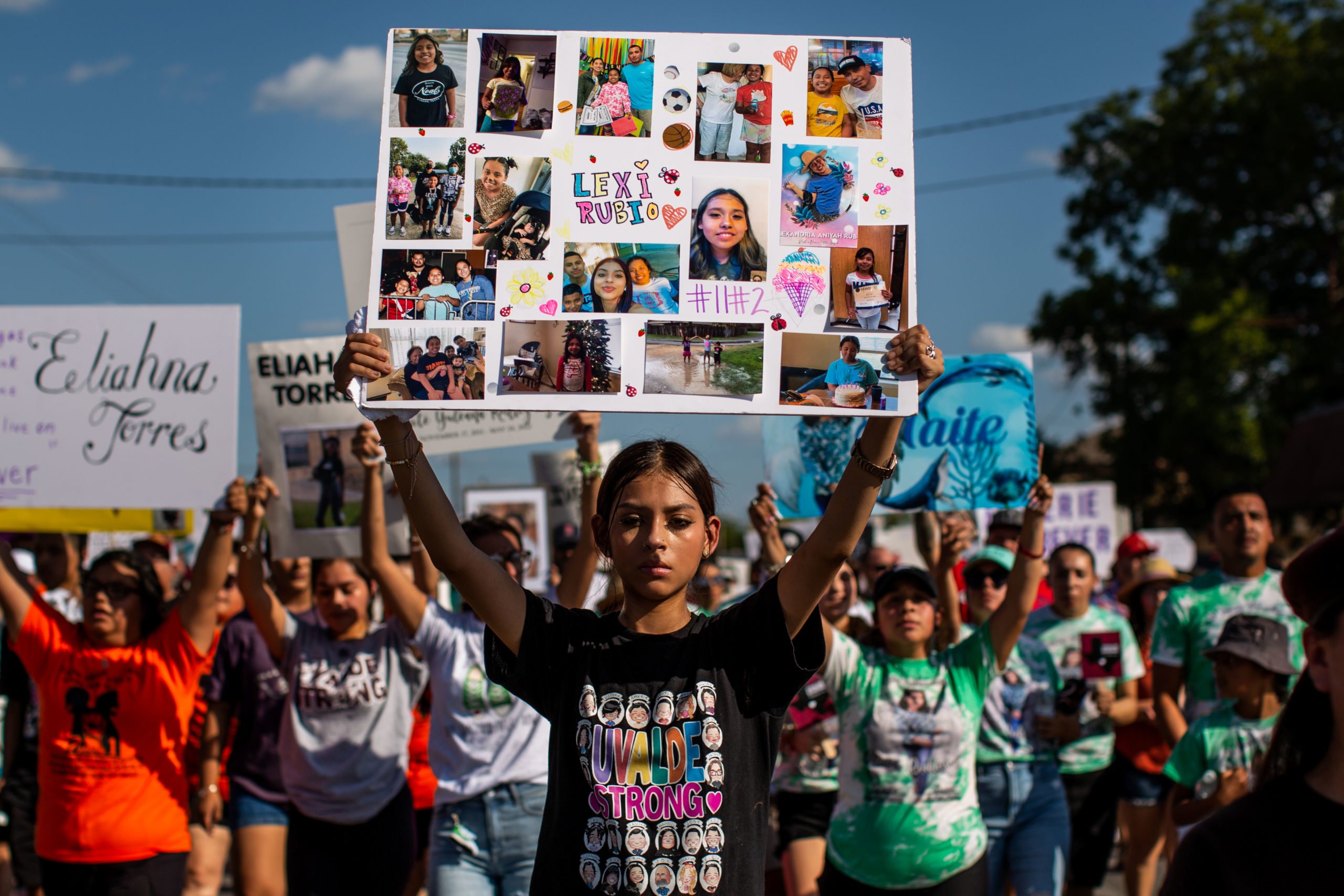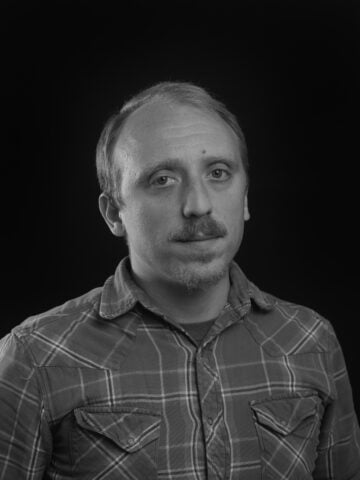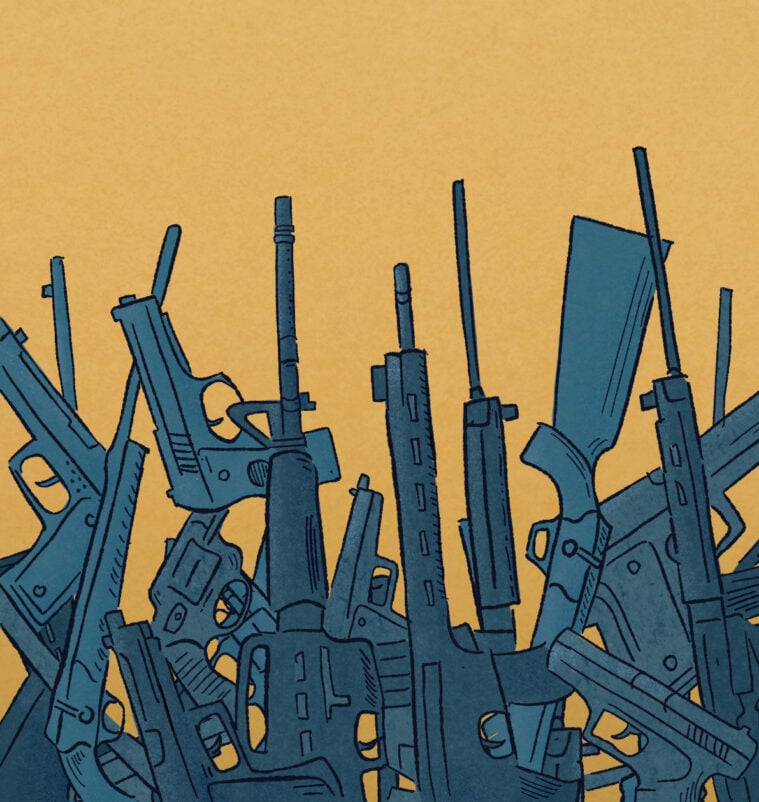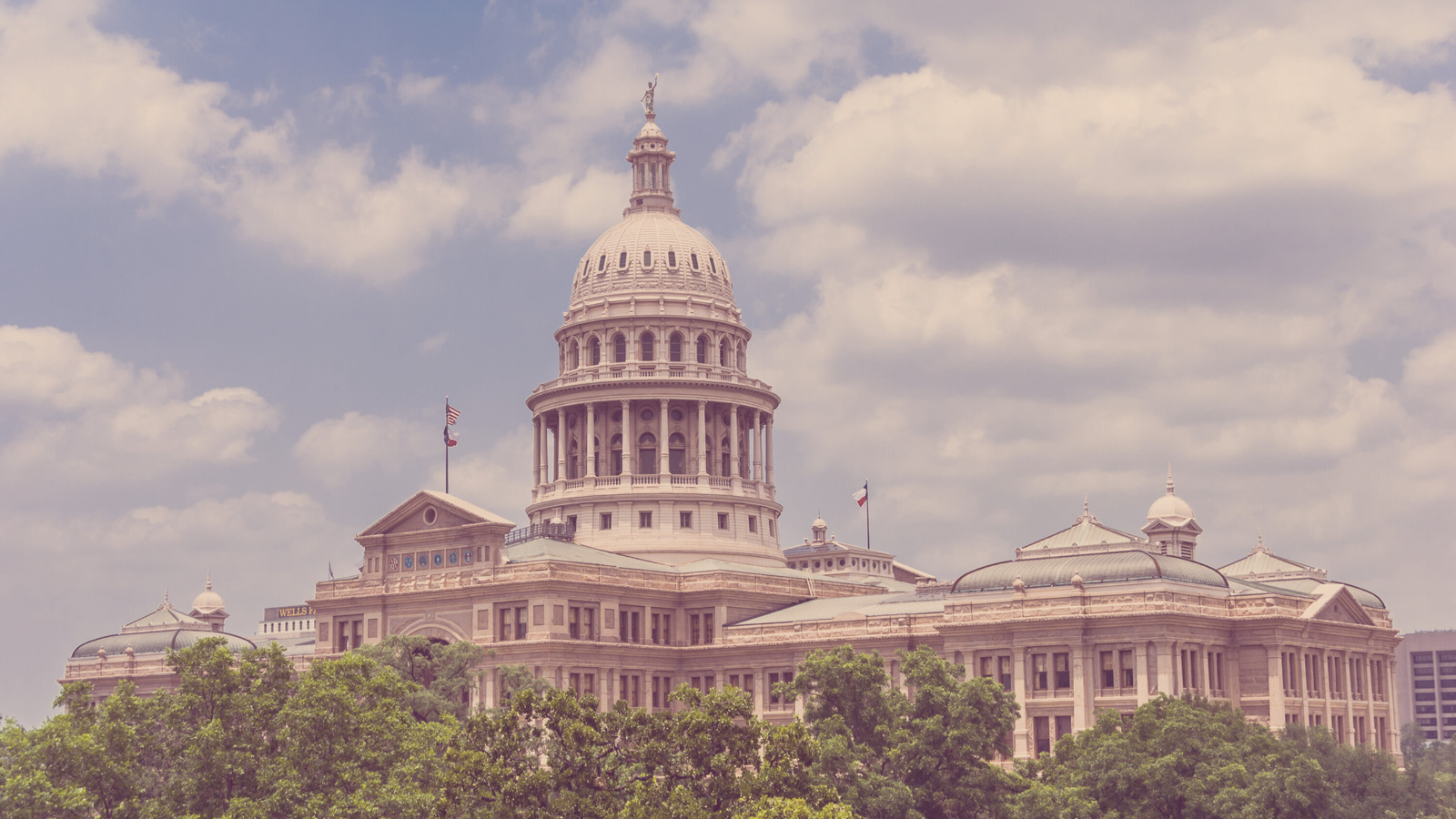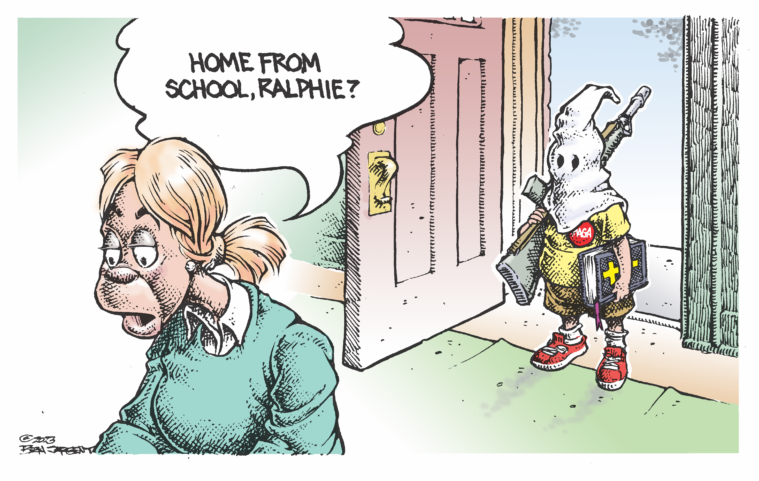On the afternoon of July 10, Lalo Castillo, a craggy-faced and sturdy 76-year-old, arrived at the northeast corner of Robb Elementary School in southwest Uvalde, where neighbors and acquaintances began assembling for the largest political protest his hometown had seen in 50 years. Long ago, he’d studied reading and math in Robb’s classrooms, his childhood home just a quarter-mile away; almost as long ago, he’d helped lead a student uprising here that reshaped his city. Now, out front of the 67-year-old school—a cluster of old low-slung brick buildings plus a newer addition, nestled in a neighborhood of metal-roofed casitas and pothole-ridden roads—he watched the crowd swell past 500.
“I was glad to see young people, children, older people, white people, all kinds of folks that are joining,” Castillo said. “It brought back a lot of memories—particularly beginning at Robb.”
Around the school’s welcome sign that day, a second gathering sprawled: a makeshift memorial overflowing with weathered teddy bears, bright flowers, handwritten letters, and white crosses. Affixed to a nearby side wall, just visible over yellow police tape and a temporary fence with black privacy mesh, a banner still blared the school slogan: “Together We Rise.” The windows of the newer building were all gone, with plywood now blocking from view the place where all the killing happened.
About seven weeks prior to the protest, an 18-year-old high school dropout—who’d been labeled by friends “the school shooter” and threatened girls online—was allowed to purchase two AR-style rifles and 2,000 rounds of ammo. On May 24, the killer, who’d attended Robb himself, shot his grandmother at a house directly behind the lot where Castillo grew up. The shooter then crashed his grandma’s pickup into a paved ditch on the school’s west side, hopped a 5-foot fence, entered an exterior door that should have been locked, entered a classroom door that should have been locked, and finally unleashed hell on earth, pulverizing and even decapitating 19 fourth-graders and two teachers with a weapon designed for just such purposes.
Multiple local cops arrived on the scene within a few minutes. The law enforcement response would swell to 376 officers from 23 separate agencies, including 149 Border Patrol agents and 91 state troopers. This small army proceeded to waste 74 minutes while preventing family members from breaching their perimeter line and despite hearing additional shots, before entering the classroom and killing the shooter. As of late August, families do not know how many lives could have been saved by police bravery; many likely died instantly, though at least a few perished en route to or at a hospital.
This tragedy, the worst-ever Texas school shooting and part of a rising tide of mass shootings nationwide, was the second time Robb Elementary School had made history. A half-century before, Robb was the focal point of a six-week walkout by Mexican-American students that would permanently change Uvalde, a typically quiet town of 15,000 some 90 minutes west of San Antonio. Since the May massacre, school officials have announced Robb will be razed, likely erasing a physical reminder of the city’s civil rights history; at the same time, a web of family members of the lost has transmuted grief into rage, launching an explosive crusade against death in vain—an ad hoc campaign for transparency, accountability, safer schools, and gun control legislation—that can only be compared, locally, to that early ’70s unrest. Uvalde, on the heels of 21 premature funerals, has erupted again.
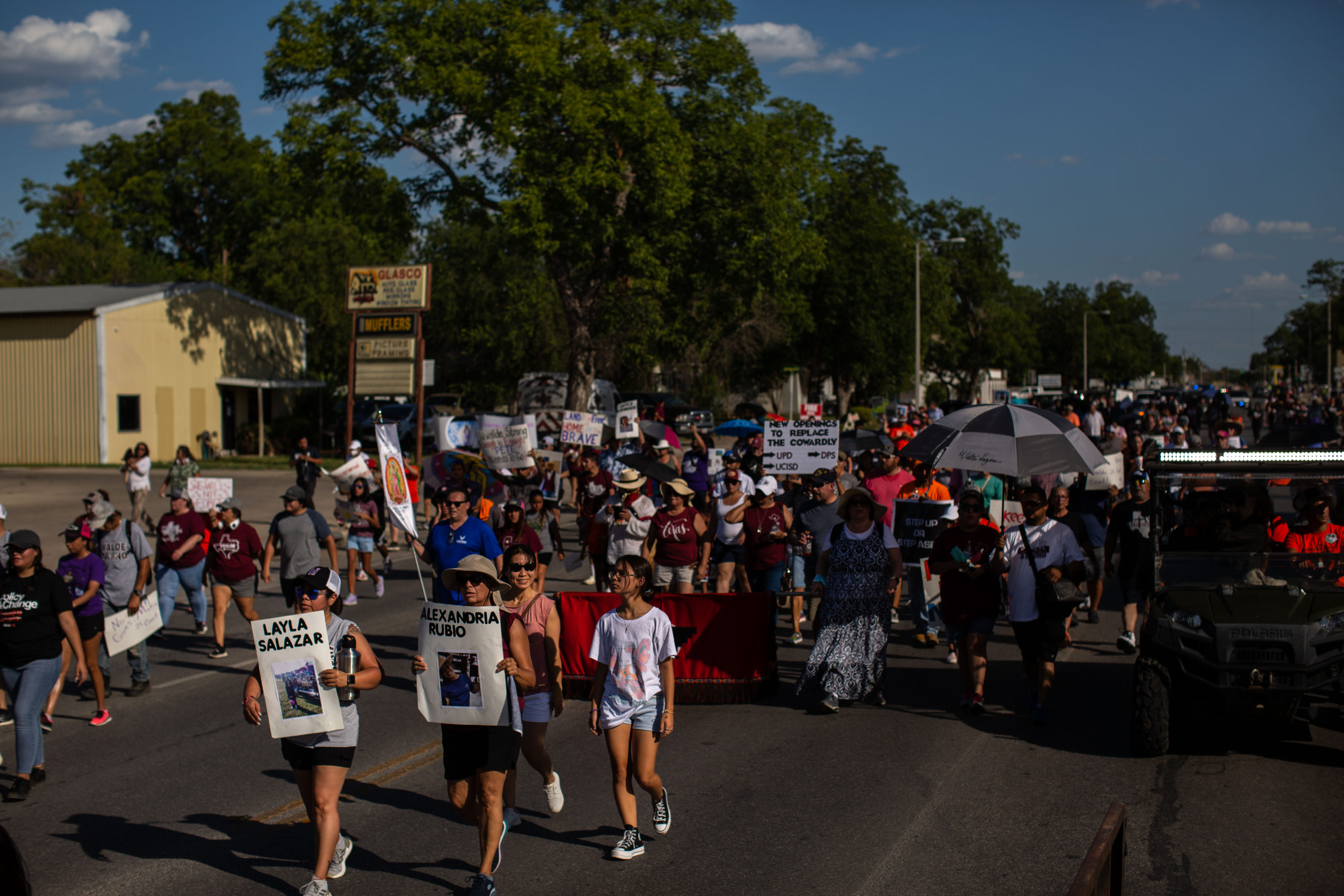
Since the shooting, Uvaldeans have marched and testified from Austin to D.C., and they’ve turned city, county, and school board meetings into seething referenda on the local status quo. Groups have formed including a new chapter of the League of United Latin American Citizens, plus Uvalde Strong for Gun Control, LivesRobbed, K.A.R.M.A., and Fierce Madres. In August, families successfully pressured the city council of nearby Hondo to cancel an event affiliated with the National Rifle Association, and they’ve joined with survivors of other mass shootings to push bipartisan gun legislation through Congress and an assault weapons ban through the U.S. House. Voter registration in Uvalde has spiked in recent months, according to the Associated Press. And on July 10, despite 104-degree heat, the “Unheard Voices March and Rally” marked the largest local protest in five decades.
Outside Robb, beneath a cruel sun, the family members gathered in matching custom-made shirts commemorating their lost loved ones, carrying signs reading “Hear Their Screams,” “You Don’t Need a Gun to Be Powerful,” and “Bullets Are Not School Supplies.” A crew of Brown Berets from multiple Texas cities passed out water bottles and shepherded participants. Vicente Salazar, a 67-year-old retired construction worker who carries himself a bit like he might throw a punch, spoke through the megaphone.
“I can’t hug my granddaughter again—not ever again. Only in my dreams can I be with her, and I cry every night because she is not here and she is not here because our system in Texas failed us,” he said, clad in a black t-shirt depicting 11-year-old Layla as an angel. He then turned to the police response: “It’s a joke; I could’ve did a better job myself if I’d been able to get through their lines.”
Salazar then joined the crowd in a mile-long march to Uvalde’s town square; having had a triple bypass and two brain surgeries before, he surprised himself a bit by pulling off the trek, he later told me.
Jazmin Cazares, a purple-haired 17-year-old who’s testified at the statehouse and sat-in outside Speaker Nancy Pelosi’s office since losing her sister Jackie, bustled about making sure things stayed on track. She and her family were the march’s main organizers.
“Everybody feels this hurt and everybody’s using this pain and this trauma and everybody’s channeling this right now and we’re gonna make change,” Cazares told a TV reporter. Gubernatorial candidate Beto O’Rourke attended the homegrown event, as did David Hogg and Sam Fuentes, two survivors-turned-activists from the 2018 Parkland shooting in Florida.
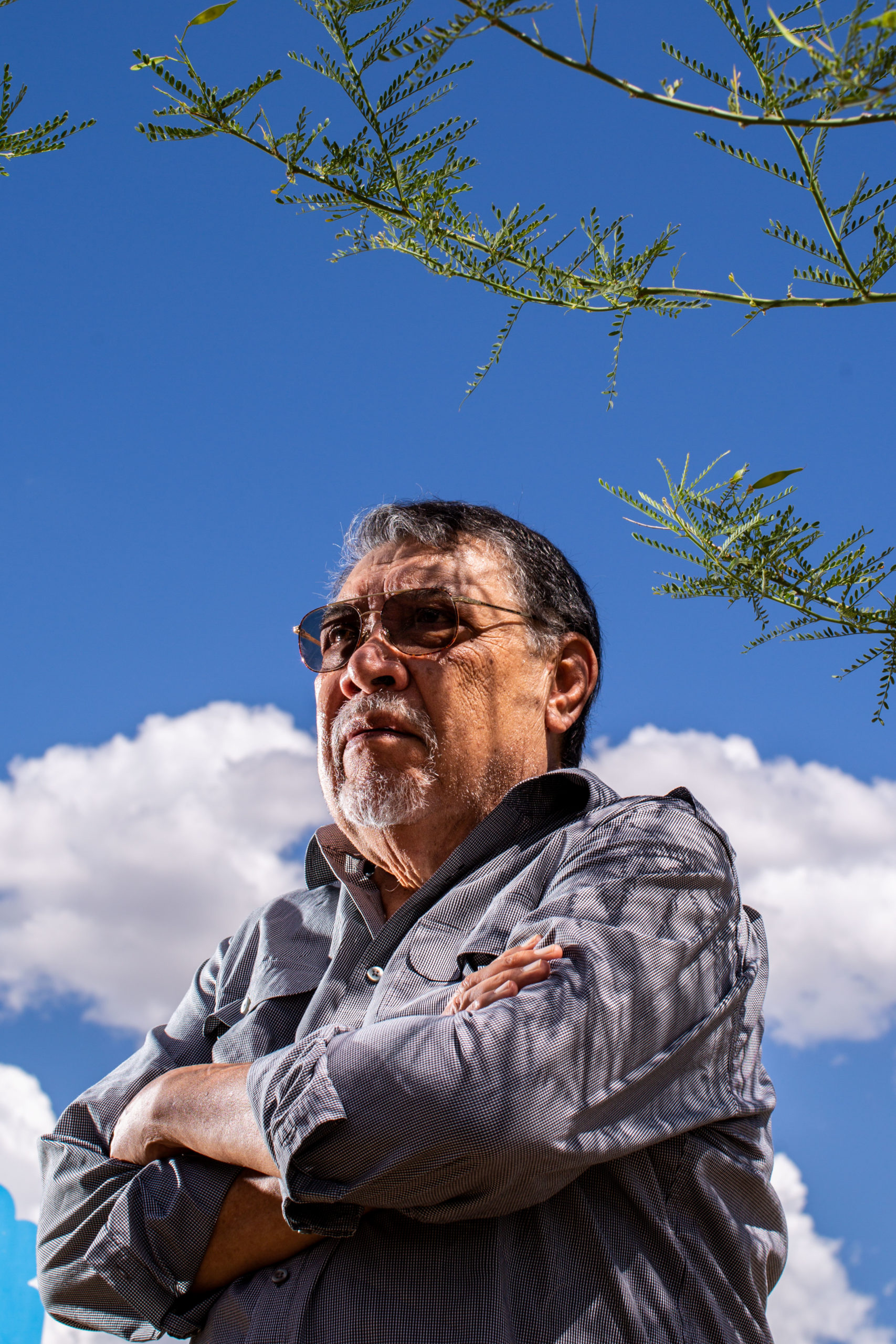
At the plaza, a stream of representatives from each family took to a podium. Most demanded the firing of Pete Arredondo, the chief of the school district police and commander at the shooting scene; some called for all police present that day to resign; many called for restrictions on assault rifles. A few barely choked out their remarks through sobs; some pledged something like a righteous vengeance.
“What I want no one can give me: I want my daughter back, and if I can’t have her, then those who failed her will never know peace,” vowed Kimberly Rubio, a former reporter for the local paper who’s given searing testimony before a U.S. House committee and joined a couple dozen other Uvaldeans in D.C. for a rally alongside survivors of the Illinois parade shooting.
For Castillo, marching hadn’t been in the cards—it was too hot, plus he has a steel rod in his leg—but he’d driven ahead with a camera to bear witness at the square. As he snapped photos, he found himself buoyed by the scene, which pulled him back to the movement of his youth. “I couldn’t help but think about that,” he said. “And all the struggle.”
Uvalde is an in-between place. Almost as far from the border city of Eagle Pass as it is from the Mexican-American metropolis of San Antonio, the town sits where the Hill Country settles into South Texas shrubland, where the centuries-old live oak and mesquite still mingle. Highways 83 and 90 split the city into quadrants, a touch askew; historically, Anglos occupy the north and northeast, Latinos the south and southwest. Uvalde has produced two towering Texas political figures: Vice President “Cactus Jack” Garner and Governor Dolph Briscoe, both Anglo. Today, the town is 82 percent Hispanic; a half-century ago, it was closer to fifty-fifty, and brutally divided.
Castillo, born in 1946 in Uvalde, recalls the segregated movie theater, the restaurants that banned “Mexicans,” and the corporal punishment for speaking Spanish at school. At the 89-percent Latino Robb Elementary in the southwest barrio, he remembers “the playground was very bare and you could tell the difference” compared to the 77-percent white Dalton Elementary, built the same year in the northeast. In 1970, a Newsweek reporter described “fadingly elegant houses … set back from graceful streets” on one side of town and “clusters of shacks assembled piece by salvaged piece” on the other. At that time, no Mexican Americans held local office. Segregation even persisted past death: If you visit the old cemetery today, south of Highway 90, you’ll see all the Spanish surnames on one end, the graves smaller and closer together. (Across the highway, the new cemetery is mixed, and lately alive day and night with the families of the shooting victims.)
In the late ’60s, discontent brewed. Latino Texans were being killed in Vietnam for a country that still shunned them. In 1967, organizers on San Antonio’s West Side formed the Mexican American Youth Organization (MAYO), soon the state’s leading vehicle for young Chicano dissent, which became active in Uvalde.
“[At the MAYO meetings] we started to learn about politics and public policy and economics and stuff like that,” said Alfredo Santos, a teenager in Uvalde at the time who, since the May 24 shooting, has relaunched a monthly newspaper called La Voz de Uvalde County. “You gotta remember we were rural small-town kids—all we knew about was how to rebuild Chevrolet engines—but as we got politicized we started to learn about César Chávez and all the others.”
In Crystal City, 40 minutes south of Uvalde, a pair of uprisings led to Mexican Americans taking over the city council and school board, and activists formed the Raza Unida political party. Student school walkouts began to spread from Edcouch to Kingsville to Abilene.
-
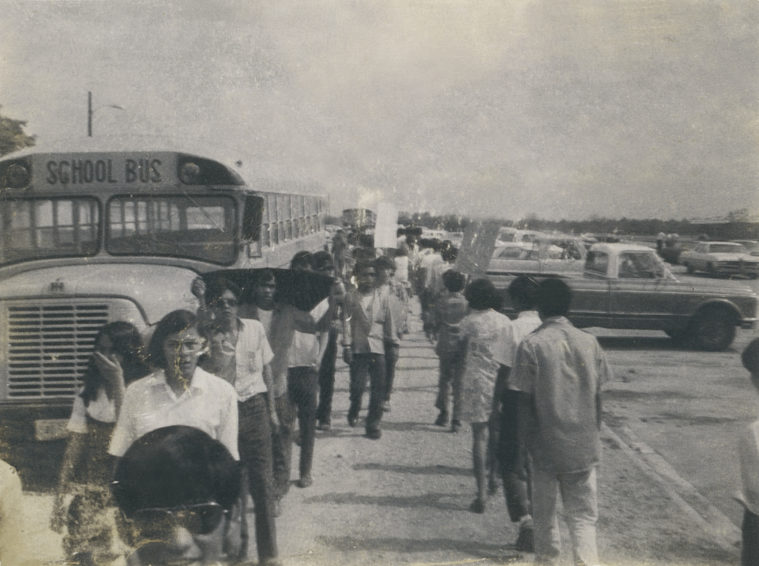
Students march during Uvalde’s 1970 walkout. Credit: Courtesy/Alfredo Santos -
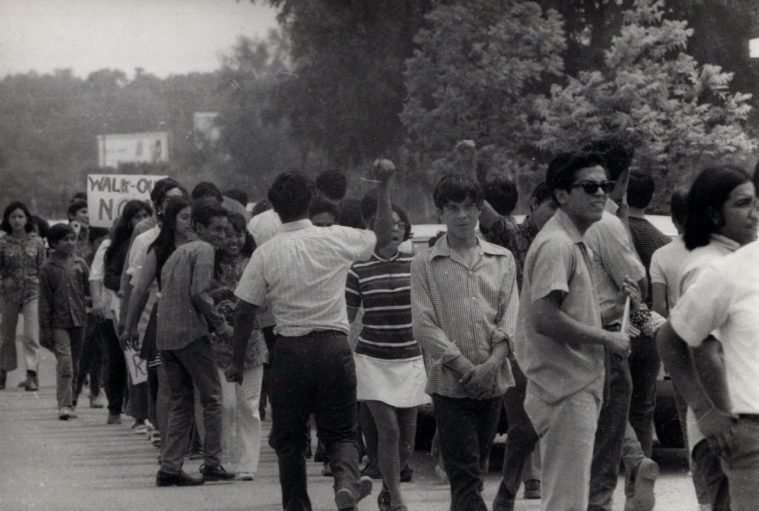
-
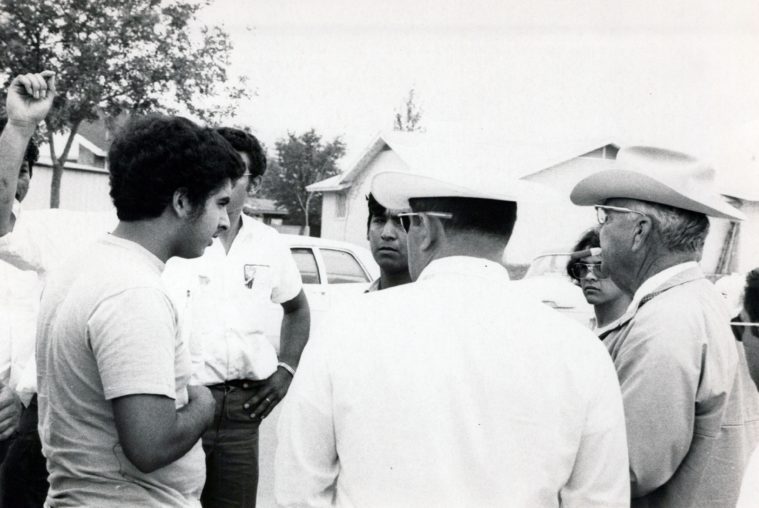
-
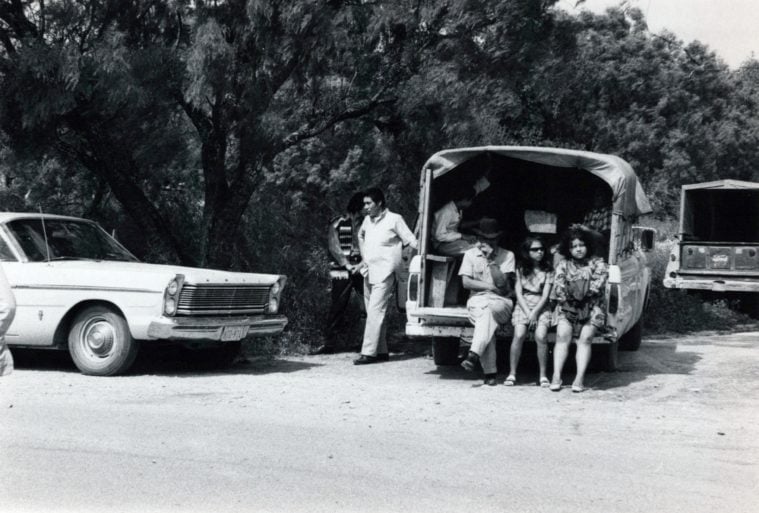
-
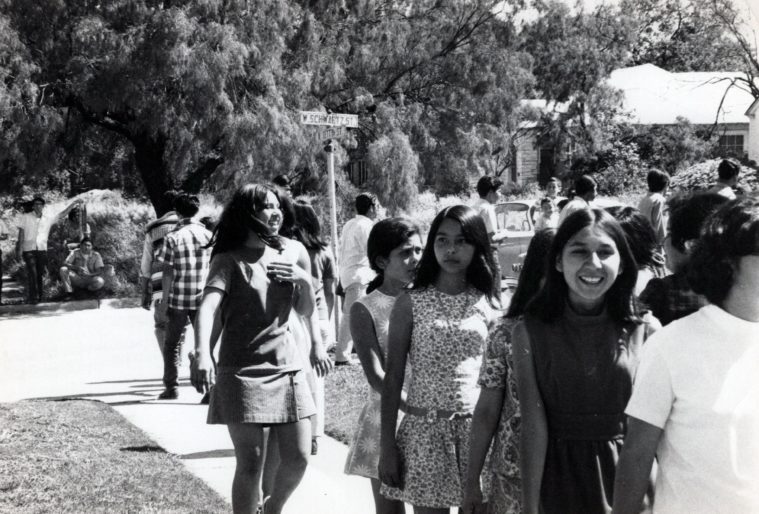
-
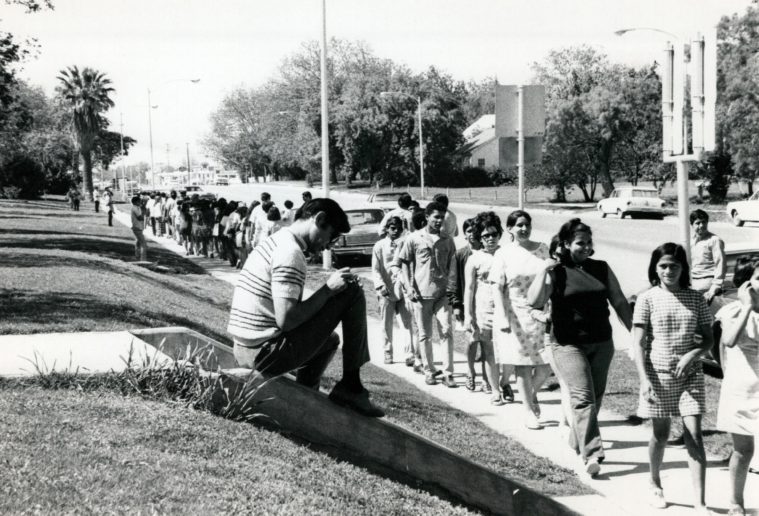
-
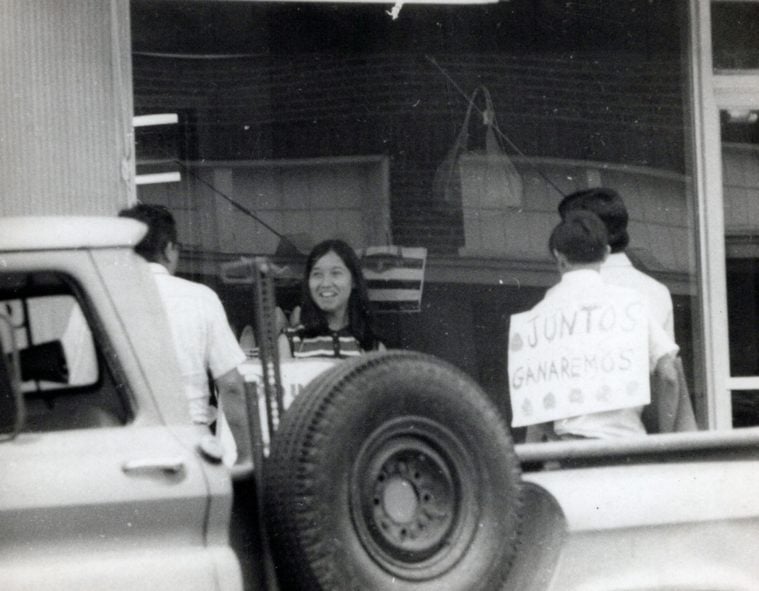
-
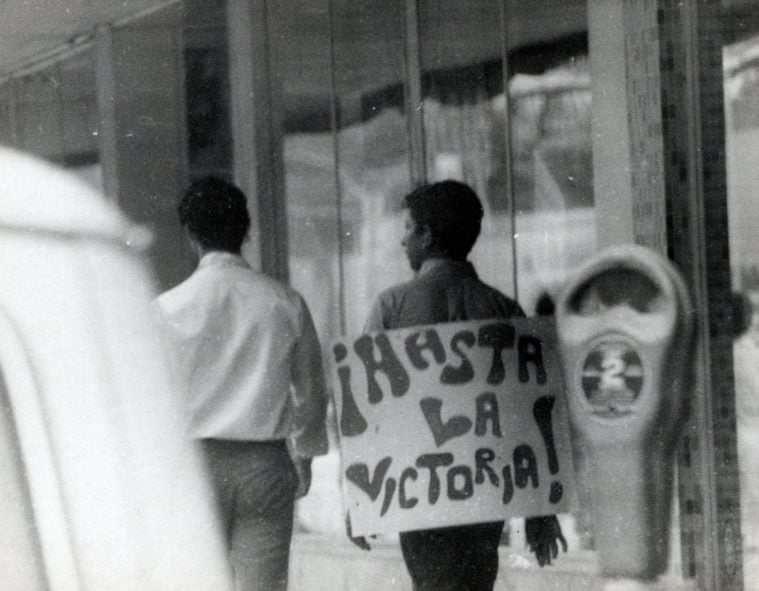
At Robb Elementary, meanwhile, a classroom teacher named George Garza strove to change things in his own way. To improve the neglected grounds, he wrangled the county and private businesses into helping lay a basketball court and plant pecan trees. He tapped Castillo to co-coach a football squad. Garza refused to punish kids for using their mother tongue, and he interpreted between the Anglo administration and Spanish-speaking parents, forming their “one real link to a decent education” at Robb, an activist said at the time.
An ambitious man, Garza also took graduate courses and decided to run for county judge, moves that Garza says made Robb’s white principal feel threatened. In March 1970, Principal E.P. Shannon informed Garza he was not recommending the latter for contract renewal—a move that incensed parents who had already been organizing and submitting grievances about neglect and discrimination. Garza sought a hearing with the all-white school board, and on April 13, Uvaldeans packed a tiny conference room to overflowing. That evening, the board declined to grant Garza a hearing, and the community declined to take “no” for an answer.
In an unpublished book draft, Santos describes the scene on the sidewalk outside: “With defiance in his voice, [parent] Gilbert Torres stammered, ‘Well, I’m not going to send my children to school tomorrow until this matter of George Garza’s teaching contract is resolved one way or another!’ … I didn’t see who said it, but from another part of the crowd came, ‘Walkout!’ Then from the other side of the crowd someone yelled, ‘Walkout mañana!’ The fire had been lit.”
The next morning, older Latino kids walked out of second period classes while parents kept little ones home. For nearly six weeks, through the end of the school year, around 500 kids per day—a quarter of the district’s Mexican-American population—boycotted classes, according to a 1992 thesis by Juan O. Sanchez. Organizers settled on a list of 14 demands, including bilingual educators and the resignation of Robb’s principal. Parents, mothers mostly, organized hundreds of meals daily and worked with the Catholic church to establish huelga schools where kids learned Mexican-American history during the day before picketing schools in the afternoon. The classes “taught me that I didn’t know an inch of what my culture was really about,” Rachel Gonzales-Hanson recalled in a recent history collection, Civil Rights in Black and Brown.
Castillo, then 24, was among the walkout’s main organizers and also filmed the events. The grainy footage, preserved by the Voces Oral History Center, shows teenagers decked out in plaid skirts and leather fringe jackets assembled around a V.W. bus and students of all ages throwing up peace signs and single fists. Marching in a circle outside Robb—almost precisely where families would launch their march 52 years later—they carried signs reading “Viva la Raza,” “We Waited Long Enough,” and—in the case of one young boy in a bright-orange shirt—“Hang the Gringo,” accompanied by a hand-drawn gallows. The video also shows the state police helicopter and Texas Rangers summoned to police the protest, including a late-career A.Y. Allee, the notorious cigar-chomping Anglo known then for his brutal handiwork breaking a 1967 farmworkers’ strike in Starr County. The footage appears to show Allee seizing a young man by the neck from the picket line and shoving him inside a police car.
In other Texas walkouts at the time, school boards tended to make some concessions to restore order. But not in Uvalde. After six weeks, the board had refused to meet a single demand. The 18-year-olds were reclassified as eligible for deployment to Vietnam, and the boycotting school children would be held back a grade. In an immediate sense, this placed Uvalde among the longest-lasting and least-successful walkouts of the era.
But Genoveva Morales wouldn’t let the walkout end in failure. With help from the then-fledgling Mexican American Legal Defense and Educational Fund, she filed suit on behalf of herself and her nine children, part of a wave of groundbreaking legal activism. Six years later, this litigation forced the district to integrate by splitting the elementary grades between schools; the courts retained oversight of the district through 2017. The number of Hispanic teachers grew through the ’70s, reaching 55 percent at the lawsuit’s close. Mexican Americans also began routinely winning city council, county commission, and school board seats; Garza, the Robb teacher, served on the school board in the ’80s and later as mayor.
On a blistering afternoon, Castillo took me on a tour of Uvalde. Once a child farmworker, he said he went on after the walkout to train with Chicago organizer Saul Alinsky and worked with César Chávez, later becoming a successful businessman. As we drove, he took every chance to point out improvements that followed the walkout: A park, which he still calls the “Mexican park,” now has a pavilion and playground equipment; Garza’s mature pecans now shade the Robb campus; and the middle school is now named after Genoveva Morales. Castillo worries people have forgotten: “A lot of people think these things just occurred,” he said. “They don’t realize it took a lot of sacrifice … because we were labeled, the FBI was on my ass, we were labeled ‘communists.’”
For many like Castillo, the walkout changed their life trajectory. Olga Muñoz Rodríquez, now 77, was “pretty much a quiet little homemaker” before she organized with other mothers in 1970, she told me. She then went on to host a radio program and run an alternative newspaper. In the last few months, from her home in San Antonio, Muñoz Rodríquez has been keenly watching the livestreams of the burgeoning parents’ movement back home, rooting for them. She sees something of herself in them, and she sees an upheaval unlike anything her hometown’s seen in decades, one that could shake up the status quo yet again.
“When the walkout came out, we were all so angry—just like these parents,” she said. “They’re using that anger; their grief has turned to anger and, hopefully, action.”
On the evening of July 18, state troopers lined the walls of Uvalde High School’s spacious John Harrell Auditorium, named for a former superintendent and father of the current superintendent. Families filed in and placed framed photos of their lost children on the front row seats. At the prior month’s board meeting, there’d been a three-minute time limit on testimony: Parents and grandparents had poured their hearts out, receiving virtually no response from a placid board. Now, at this meeting specially called for public input, families weren’t taking “no” for an answer.
“We have a lot to say and we won’t be silenced. We won’t be stopped. So if y’all have any idea of a time limit, it’s not going to be followed this time,” said Brett Cross, uncle and guardian of 10-year-old shooting victim Uziyah “Uzi” Garcia. As Cross proceeded to grill the board and Superintendent Hal Harrell about unlocked school doors and unaccountable cops, the crowd cheered him on. When a query was met with silence, someone would shout: “Answer the question!” Off to the side, one man stood holding signs reading “Prosecute Pete Arredondo” and “We Want Accountability.”
Castillo, sitting a few rows from the front, turned to me and whispered: “I love how these people are organized.” Thus far, he’d simply stayed on the sidelines—he’s an old man, with grandkids in Austin to be visiting—but this night he’ll decide to reach out to the families to see if he can help.
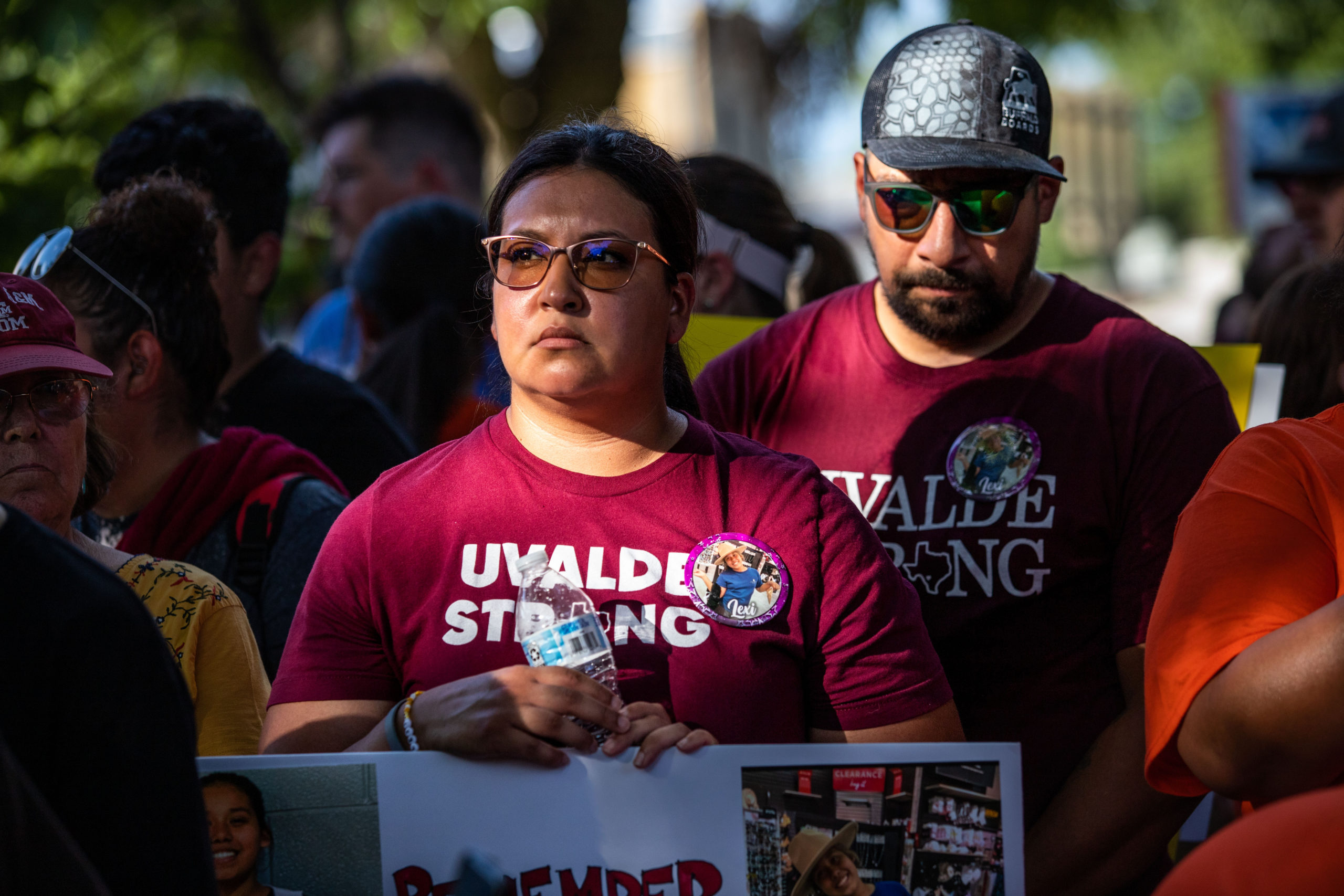
These days, Latinos hold a fair number of elected positions in Uvalde, but some of the most powerful roles, including mayor and county judge, are in Anglo hands. There are two women total between the city council, county commission, and school board. Uvalde County, 73 percent Latino, went for Trump in both 2020 and 2016. Turnout tends to be lower than the state average but higher than in border counties like Webb or Hidalgo. Law enforcement, supersized through expansive border security initiatives, is enmeshed in the local economy and politics. Arredondo, the school district police chief, was elected to city council three weeks before the shooting—a position he’s since vacated, opening a seat to be filled in November—and Mariano Pargas, the acting chief of the city police at the shooting scene, is a county commissioner. Both were put on leave from their law enforcement jobs, and Arredondo was finally fired August 24.
Another major source of employment in Uvalde, where 21 percent live in poverty, is the school district—meaning the shooting has struck at trust in the city’s core institutions. Campus segregation is no longer an issue: All the schools are 90 percent Hispanic. But documents from the Morales lawsuit show that in recent years the district’s white students continued to see better outcomes than Latinos; in 2019, Robb had a failing grade from the state education agency. The district was already struggling with declining enrollment, in part due to transfers to neighboring school systems, a trend that may intensify following the shooting.
In addition to the firing of Arredondo, the city and county have promised investigations of all their officers’ actions, the school district has begun implementing security measures including taller fencing and more cops, and all three entities have issued resolutions urging Governor Greg Abbott to call a special legislative session to raise the age for buying AR-style rifles from 18 to 21. But for the bereaved—who don’t want to see the cops who failed their kids in uniform again, and don’t want other families to suffer what they’ve suffered—it’s hardly enough. Some want to see every officer there that day without a badge; some want to see the whole school board step down; and, it goes without saying, Governor Abbott is likely to ignore the calls for a special session. At least one lawsuit has been filed against the estate of the killer, and more are sure to follow.
As for Robb, plans so far are to tear it down, possibly replacing the now-blighted buildings with a permanent memorial while erecting a new school elsewhere. No definite timeline has been announced. In September, Robb students and staff are slated to start a delayed academic year at another location, a former elementary campus, a mile and a half from their old school.
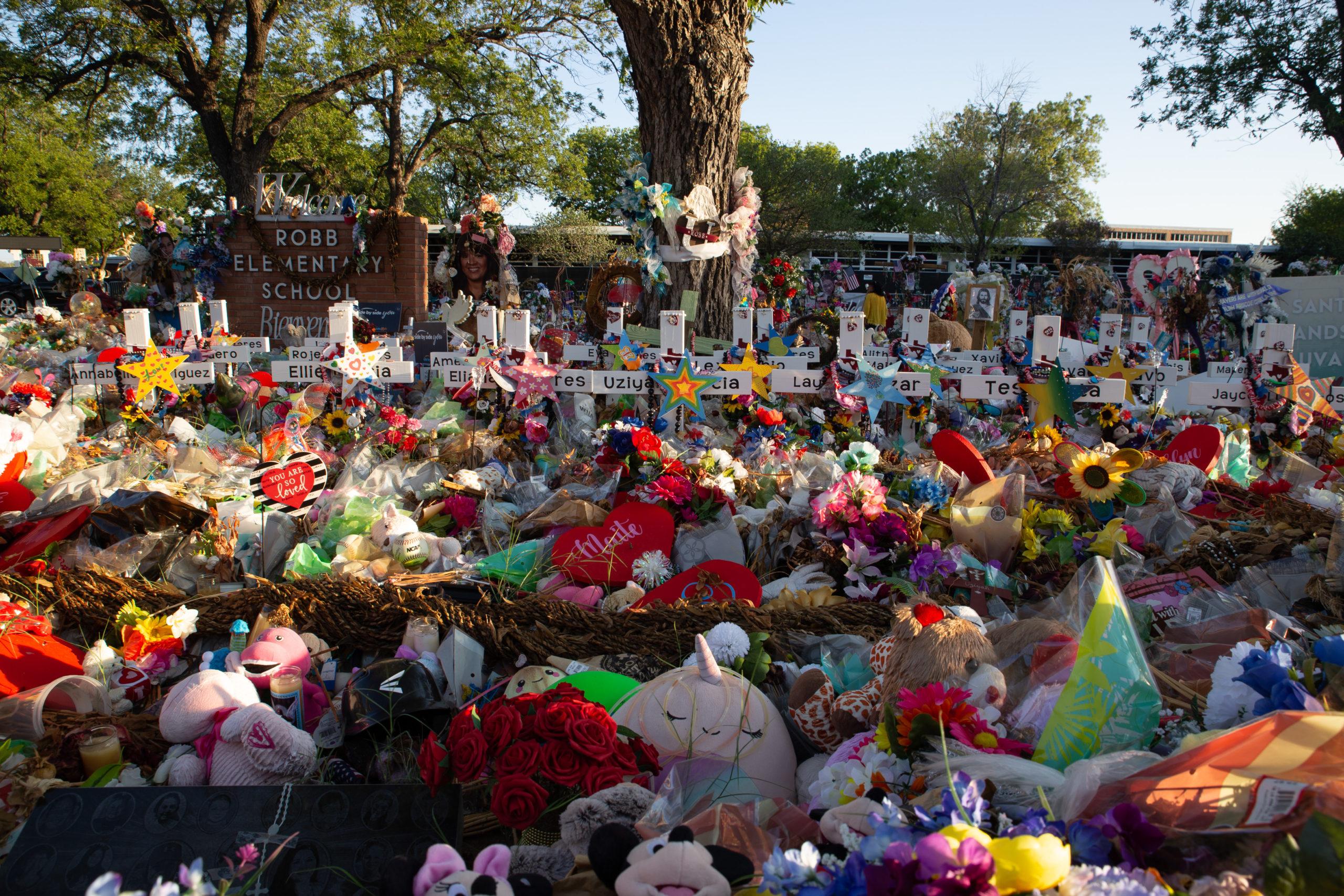
At the high school auditorium, the July special board meeting—intended to last 45 minutes—topped three hours. Tina Quintanilla-Taylor, who ran unsuccessfully for a board seat in 2020, warned: “No more good old boy system here. … Your schools, they suck, they’re not secure, and we’re not sending our kids back.” Another speaker, who lives by Robb, promised future vigilance: “We’re awake now, and I don’t think any person in this room is gonna let anything slide ever again.” Enjoying the combative testimony, Castillo periodically chimed in, shouting things like “incompetent.”
Salazar, the pugnacious grandfather, swaggered to the podium. “I can hold myself together now because I’ve done my crying, now it’s time to do my fighting,” he declared, as the crowd erupted. “You’ve seen me in the papers, and you will see me in the papers a lot more, because this isn’t the end, this is just the beginning.”
Berlinda Arreola, a perpetual presence at recent meetings and grandmother to 10-year-old Amerie Jo Garza—whose dream of being an art teacher was cut short May 24—made a specific pledge that caught Castillo’s ear. If the board didn’t satisfy their demands come fall, Arreola said, “We are prepared to walk out.”
